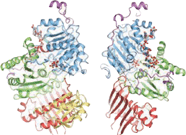
Photo from wikipedia
UPF1 is a core protein in the nonsense mRNA degradation (NMD) surveillance pathway that degrades aberrant mRNA. UPF1 has both ATPase and RNA helicase activities, but it exhibits mutually exclusive… Click to show full abstract
UPF1 is a core protein in the nonsense mRNA degradation (NMD) surveillance pathway that degrades aberrant mRNA. UPF1 has both ATPase and RNA helicase activities, but it exhibits mutually exclusive binding of ATP and RNA. This suggests intricate allosteric coupling between ATP and RNA binding that remains unresolved. In this study, we used molecular dynamics simulations and dynamic network analyses to probe the dynamics and free energy landscapes covering UPF1 crystal structures resolved in the Apo state, the ATP bound state, and the ATP-RNA bound (catalytic transition) state. Free energy calculations show that in the presence of ATP and RNA, the transition from the Apo state to the ATP bound state is an uphill process but becomes a downhill process when transitioning to the catalytic transition state. Allostery potential analyses reveal that the Apo and catalytic transition states are mutually allosterically activated toward each other, reflecting the intrinsic ATPase function of UPF1. The Apo state is also allosterically activated toward the ATP bound state. However, binding ATP alone leads to an allosterically trapped state that is difficult to revert to either the Apo or the catalytic transition state. The high allostery potential of Apo UPF1 toward different states results in a "first come, first served" mechanism that requires the synergistic binding of ATP and RNA to drive the ATPase cycle. Our results reconcile UPF1's ATPase and RNA helicase activities within an allostery framework and may apply to other SF1 helicases, as we demonstrate that UPF1's allostery signaling pathways prefer the RecA1 domain over the equally fold-conserved RecA2 domain, and this preference coincides with higher sequence conservation in the RecA1 domain across typical human SF1 helicases.
Journal Title: Journal of chemical information and modeling
Year Published: 2023
Link to full text (if available)
Share on Social Media: Sign Up to like & get
recommendations!